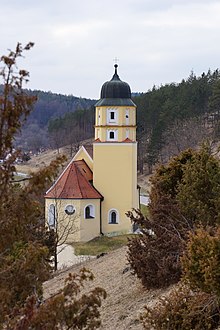Pilgrimage Church of the Visitation of the Virgin Mary (Stettkirchen)
The listed Roman Catholic pilgrimage church of the Visitation of the Virgin Mary is located in the Stettkirchen district of the Oberpfälzer Markt Hohenburg in the Amberg-Sulzbach district of Bavaria . The patronage is celebrated on July 2nd. The pilgrimage church belongs to the parish Adertshausen .
history
According to local tradition, the pilgrimage church is said to go back to a vow made by Emperor Otto II , who got into trouble here in 976 with Duke Heinrich the brawler in a battle; the site of the battle, a forest valley south of Mendorferbuch , is popularly called Bloutgraben . At that time, the emperor is said to have pushed his general staff into the ground and, in the event of his victory, praised the building of a church ( standing churches ) at this point and then realized it. Despite its historical connections, this story belongs to the area of legend .
Written news about the church has only been available since 1391. The pilgrimage is said to have started in the 15th century. A letter of indulgence from the Pope from 1468 proves that it was already a popular pilgrimage church in the late Middle Ages. Since the Hohenburg rule belonged to the Regensburg bishop's sphere of influence , the church did not participate in the religious change to Lutheranism and Calvinism typical of Upper Palatinate and it came also to no interruption of the pilgrimage tradition. These pilgrimages still take place today.
Especially after the Thirty Years War , the pilgrimages to Stettkirchen increased and the church had to be expanded. In 1656 the church was expanded to the west; this was financed exclusively from the sacrificial funds as well as manual and clamping services . The building material, like the Romanesque “Thürgericht” on the south side, came from the now ruined Adertshausen Castle . In 1691 the choir was rebuilt.
When the road was lowered through the Lauterach Valley in 2011, graves were found that date back to the 8th and 9th centuries; the burial site was used until the 15th century; the grave goods (bronze earrings, temple rings, silver earrings of Byzantine origin) are of Slavic origin. One can therefore assume that there used to be a cemetery here, but this was completely forgotten after the construction of the pilgrimage church.
Construction
The core of the pilgrimage church is a Romanesque hall building with a retracted choir closed on three sides . In the northern choir corner is the mighty tower with a bell roof , this is to be addressed as medieval up to the height of the roof ridge. Around 1600 the construction with the bell helmet took place on an octagonal substructure and Romanesque round arches. The aforementioned Romanesque arched portal is located on the south side . The church is said to be late Gothic , but there are Romanesque parts of the wall. A renovation took place between 1977 and 1983.
Interior
The interior is mainly from the 18th century. The flat ceiling with the stucco was created in 1733. The Marian monogram in the middle of the room consists of 25 individual symbols with events from the Old and New Testaments . Statements from the Song of Songs are shown on eight cartouches on the edges of the ceiling and refer to Mary .
The miraculous image was moved from a side to the high altar in 1766; it is a crescent moon Madonna . The picture is dated to the 15th century.
Bells
In the church there were three bells cast by Georg Schelchshorn in 1653. During the Second World War , the church bells were confiscated and dismantled in 1942/1943. They were shipped to Hamburg and were to be melted down at the Hamburg bell cemetery . After the Second World War, however, they could be found intact. One specimen broke on the return journey; since the end of the 1940s, Stettkirchen only had two bells.
On May 13, 2016, a third bell in the Hessian sense was manufactured in the Rinker foundry . It weighs 310 kilograms and is 80 centimeters wide. Its patron saint is the Madonna on the crescent moon. It was consecrated by Auxiliary Bishop Reinhard Pappenberger .
literature
- Mathias Conrad: Stettkirchen in Lauterbachtal. In: amberg information , October 1993, pp. 19-25.
Web links
- The pilgrimage church of Stettkirchen. In: Negotiations of the historical association for Upper Palatinate and Regensburg. 1849, volumes 13-14, 245-256, accessed June 15, 2020.
- Pilgrimage Church of the Visitation of the Virgin Mary.
- Maria Visitation Stettkirchen on aerial photo Laumer accessed on June 15, 2020.
- Mathias Hensch: The early and high medieval cemetery at the Church of St. Maria Visitation in Stettkirchen near Hohenburg - a working status for the evaluations of the 2010/2011 excavations. In: The Eisengau. Volume 46, 2016, pp. 113–157, accessed June 15, 2020.
Individual evidence
- ↑ On foot and bike pilgrimage to Stettkirchen , accessed on June 16, 2020.
- ↑ Paul Böhm: Secret in the Shadow of the Church Tower Mittelbayerische Zeitung of February 26, 2016, accessed on June 16, 2020.
- ^ Paul Böhm: Stettkirchener Wallfahrtskirche The Riddle of 150 Onetz Graves from February 25, 2016, accessed on June 16, 2020.
- ^ Paul Böhm: 1040 years of the Stettkirchen pilgrimage church - new bell for the anniversary. Onetz . July 5, 2016, accessed June 16, 2020.
Coordinates: 49 ° 17 ′ 33 " N , 11 ° 48 ′ 49.2" E

